rear view mirror FIAT DUCATO BASE CAMPER 2015 Owner handbook (in English)
[x] Cancel search | Manufacturer: FIAT, Model Year: 2015, Model line: DUCATO BASE CAMPER, Model: FIAT DUCATO BASE CAMPER 2015Pages: 367, PDF Size: 19.73 MB
Page 13 of 367
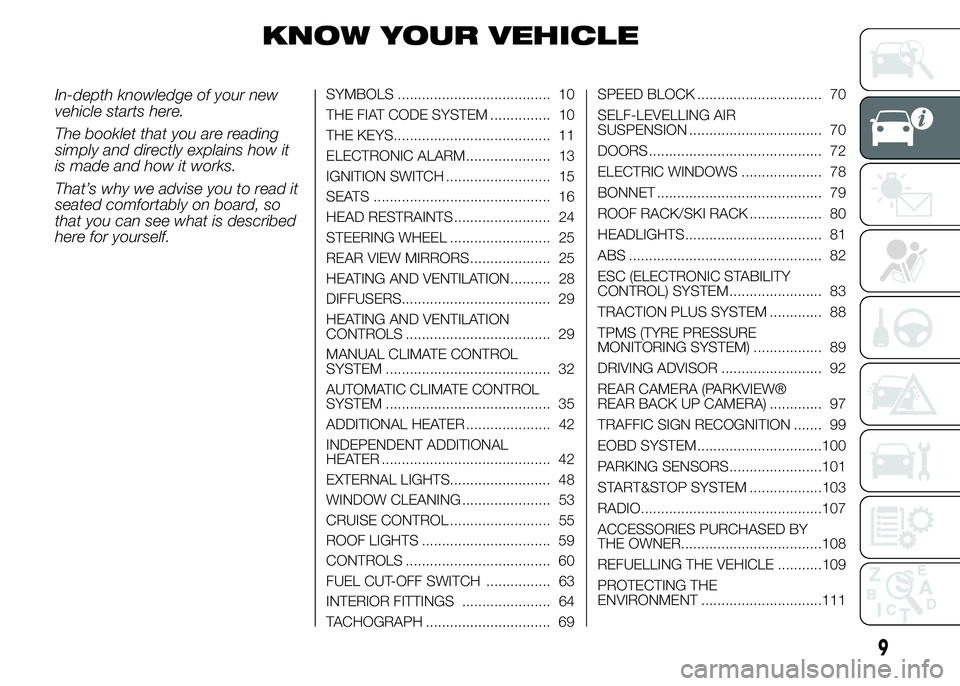
KNOW YOUR VEHICLE
In-depth knowledge of your new
vehicle starts here.
The booklet that you are reading
simply and directly explains how it
is made and how it works.
That’s why we advise you to read it
seated comfortably on board, so
that you can see what is described
here for yourself.SYMBOLS ...................................... 10
THE FIAT CODE SYSTEM ............... 10
THE KEYS....................................... 11
ELECTRONIC ALARM..................... 13
IGNITION SWITCH .......................... 15
SEATS ............................................ 16
HEAD RESTRAINTS ........................ 24
STEERING WHEEL ......................... 25
REAR VIEW MIRRORS .................... 25
HEATING AND VENTILATION.......... 28
DIFFUSERS..................................... 29
HEATING AND VENTILATION
CONTROLS .................................... 29
MANUAL CLIMATE CONTROL
SYSTEM ......................................... 32
AUTOMATIC CLIMATE CONTROL
SYSTEM ......................................... 35
ADDITIONAL HEATER ..................... 42
INDEPENDENT ADDITIONAL
HEATER .......................................... 42
EXTERNAL LIGHTS......................... 48
WINDOW CLEANING ...................... 53
CRUISE CONTROL ......................... 55
ROOF LIGHTS ................................ 59
CONTROLS .................................... 60
FUEL CUT-OFF SWITCH ................ 63
INTERIOR FITTINGS ...................... 64
TACHOGRAPH ............................... 69SPEED BLOCK ............................... 70
SELF-LEVELLING AIR
SUSPENSION ................................. 70
DOORS ........................................... 72
ELECTRIC WINDOWS .................... 78
BONNET ......................................... 79
ROOF RACK/SKI RACK .................. 80
HEADLIGHTS.................................. 81
ABS ................................................ 82
ESC (ELECTRONIC STABILITY
CONTROL) SYSTEM ....................... 83
TRACTION PLUS SYSTEM ............. 88
TPMS (TYRE PRESSURE
MONITORING SYSTEM) ................. 89
DRIVING ADVISOR ......................... 92
REAR CAMERA (PARKVIEW®
REAR BACK UP CAMERA) ............. 97
TRAFFIC SIGN RECOGNITION ....... 99
EOBD SYSTEM...............................100
PARKING SENSORS.......................101
START&STOP SYSTEM ..................103
RADIO.............................................107
ACCESSORIES PURCHASED BY
THE OWNER...................................108
REFUELLING THE VEHICLE ...........109
PROTECTING THE
ENVIRONMENT ..............................111
9
Page 29 of 367
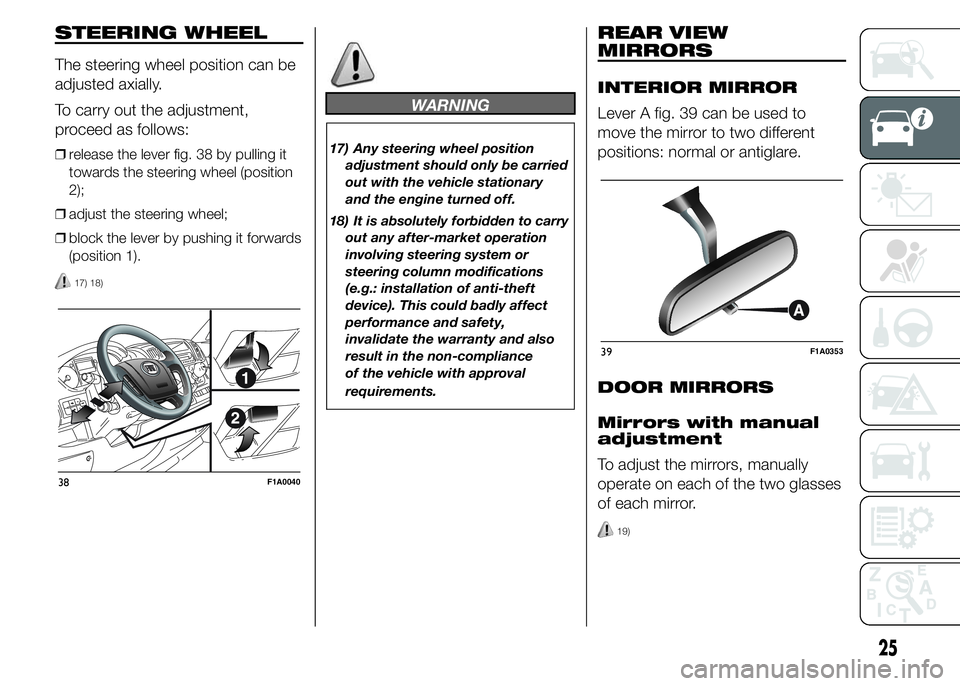
STEERING WHEEL
The steering wheel position can be
adjusted axially.
To carry out the adjustment,
proceed as follows:
❒release the lever fig. 38 by pulling it
towards the steering wheel (position
2);
❒adjust the steering wheel;
❒block the lever by pushing it forwards
(position 1).
17) 18)
WARNING
17) Any steering wheel position
adjustment should only be carried
out with the vehicle stationary
and the engine turned off.
18) It is absolutely forbidden to carry
out any after-market operation
involving steering system or
steering column modifications
(e.g.: installation of anti-theft
device). This could badly affect
performance and safety,
invalidate the warranty and also
result in the non-compliance
of the vehicle with approval
requirements.
REAR VIEW
MIRRORS
INTERIOR MIRROR
Lever A fig. 39 can be used to
move the mirror to two different
positions: normal or antiglare.
DOOR MIRRORS
Mirrors with manual
adjustment
To adjust the mirrors, manually
operate on each of the two glasses
of each mirror.
19)
38F1A0040
39F1A0353
25
Page 31 of 367
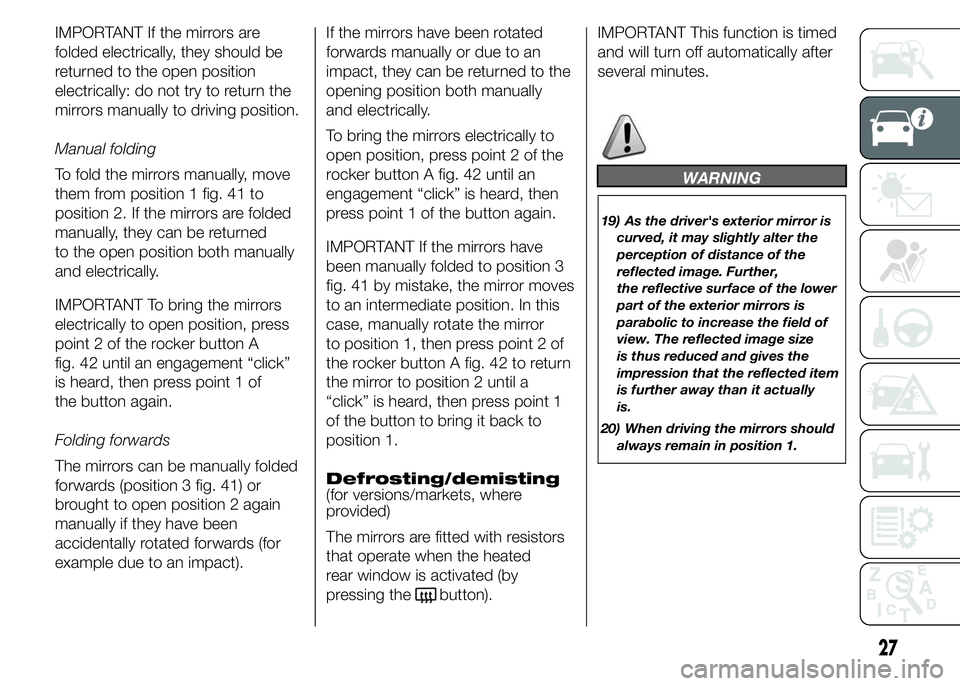
IMPORTANT If the mirrors are
folded electrically, they should be
returned to the open position
electrically: do not try to return the
mirrors manually to driving position.
Manual folding
To fold the mirrors manually, move
them from position 1 fig. 41 to
position 2. If the mirrors are folded
manually, they can be returned
to the open position both manually
and electrically.
IMPORTANT To bring the mirrors
electrically to open position, press
point 2 of the rocker button A
fig. 42 until an engagement “click”
is heard, then press point 1 of
the button again.
Folding forwards
The mirrors can be manually folded
forwards (position 3 fig. 41) or
brought to open position 2 again
manually if they have been
accidentally rotated forwards (for
example due to an impact).If the mirrors have been rotated
forwards manually or due to an
impact, they can be returned to the
opening position both manually
and electrically.
To bring the mirrors electrically to
open position, press point 2 of the
rocker button A fig. 42 until an
engagement “click” is heard, then
press point 1 of the button again.
IMPORTANT If the mirrors have
been manually folded to position 3
fig. 41 by mistake, the mirror moves
to an intermediate position. In this
case, manually rotate the mirror
to position 1, then press point 2 of
the rocker button A fig. 42 to return
the mirror to position 2 until a
“click” is heard, then press point 1
of the button to bring it back to
position 1.
Defrosting/demisting
(for versions/markets, where
provided)
The mirrors are fitted with resistors
that operate when the heated
rear window is activated (by
pressing the
button).IMPORTANT This function is timed
and will turn off automatically after
several minutes.
WARNING
19) As the driver's exterior mirror is
curved, it may slightly alter the
perception of distance of the
reflected image. Further,
the reflective surface of the lower
part of the exterior mirrors is
parabolic to increase the field of
view. The reflected image size
is thus reduced and gives the
impression that the reflected item
is further away than it actually
is.
20) When driving the mirrors should
always remain in position 1.
27
Page 41 of 367
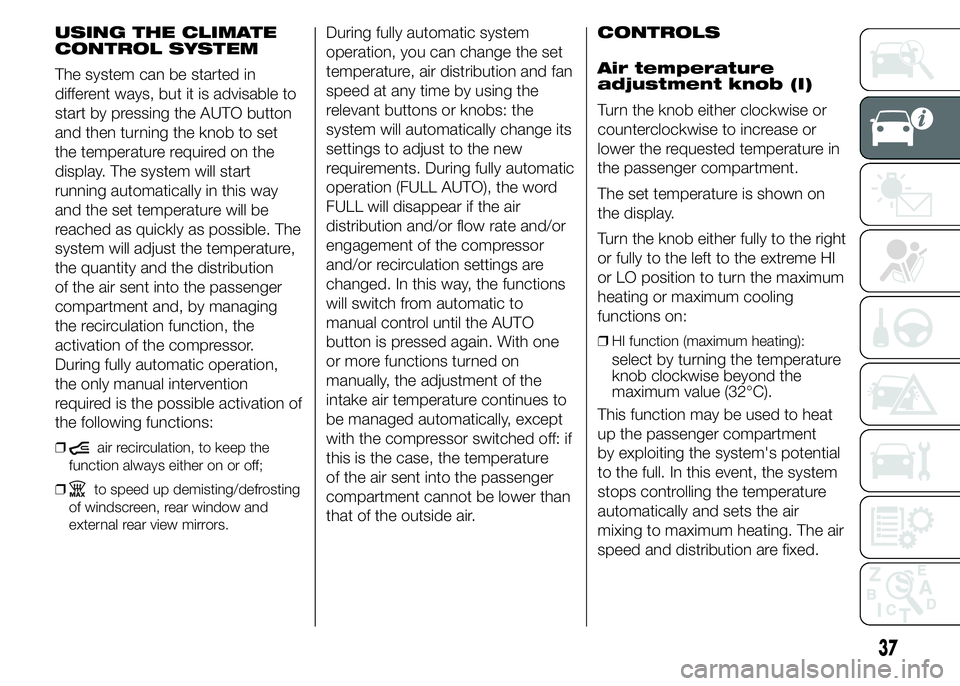
USING THE CLIMATE
CONTROL SYSTEM
The system can be started in
different ways, but it is advisable to
start by pressing the AUTO button
and then turning the knob to set
the temperature required on the
display. The system will start
running automatically in this way
and the set temperature will be
reached as quickly as possible. The
system will adjust the temperature,
the quantity and the distribution
of the air sent into the passenger
compartment and, by managing
the recirculation function, the
activation of the compressor.
During fully automatic operation,
the only manual intervention
required is the possible activation of
the following functions:
❒air recirculation, to keep the
function always either on or off;
❒
to speed up demisting/defrosting
of windscreen, rear window and
external rear view mirrors.
During fully automatic system
operation, you can change the set
temperature, air distribution and fan
speed at any time by using the
relevant buttons or knobs: the
system will automatically change its
settings to adjust to the new
requirements. During fully automatic
operation (FULL AUTO), the word
FULL will disappear if the air
distribution and/or flow rate and/or
engagement of the compressor
and/or recirculation settings are
changed. In this way, the functions
will switch from automatic to
manual control until the AUTO
button is pressed again. With one
or more functions turned on
manually, the adjustment of the
intake air temperature continues to
be managed automatically, except
with the compressor switched off: if
this is the case, the temperature
of the air sent into the passenger
compartment cannot be lower than
that of the outside air.CONTROLS
Air temperature
adjustment knob (I)
Turn the knob either clockwise or
counterclockwise to increase or
lower the requested temperature in
the passenger compartment.
The set temperature is shown on
the display.
Turn the knob either fully to the right
or fully to the left to the extreme HI
or LO position to turn the maximum
heating or maximum cooling
functions on:
❒HI function (maximum heating):
select by turning the temperature
knob clockwise beyond the
maximum value (32°C).
This function may be used to heat
up the passenger compartment
by exploiting the system's potential
to the full. In this event, the system
stops controlling the temperature
automatically and sets the air
mixing to maximum heating. The air
speed and distribution are fixed.
37
Page 58 of 367
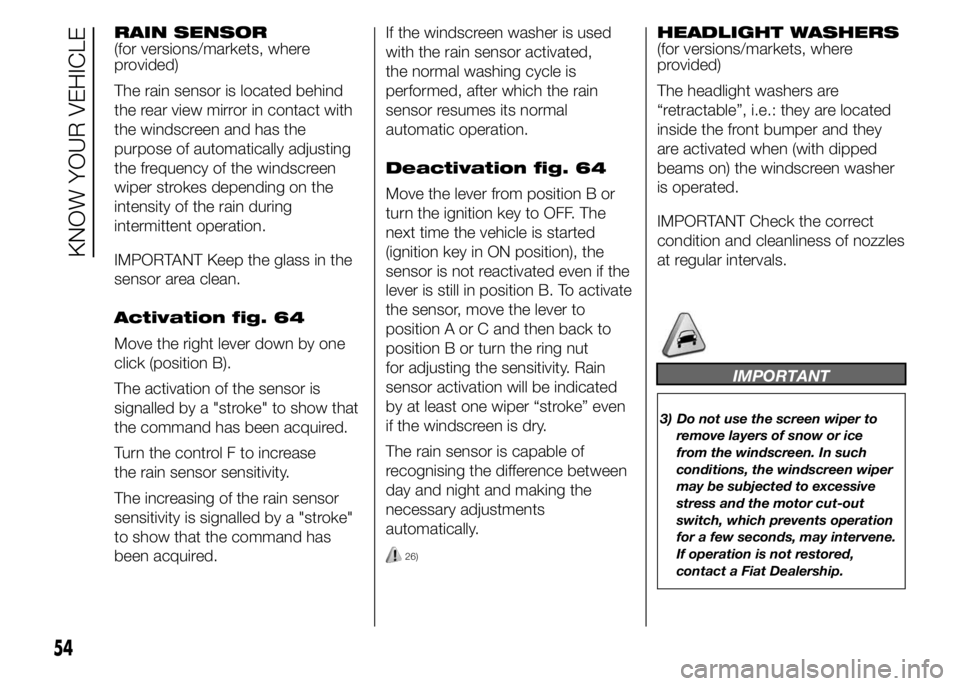
RAIN SENSOR
(for versions/markets, where
provided)
The rain sensor is located behind
the rear view mirror in contact with
the windscreen and has the
purpose of automatically adjusting
the frequency of the windscreen
wiper strokes depending on the
intensity of the rain during
intermittent operation.
IMPORTANT Keep the glass in the
sensor area clean.
Activation fig. 64
Move the right lever down by one
click (position B).
The activation of the sensor is
signalled by a "stroke" to show that
the command has been acquired.
Turn the control F to increase
the rain sensor sensitivity.
The increasing of the rain sensor
sensitivity is signalled by a "stroke"
to show that the command has
been acquired.If the windscreen washer is used
with the rain sensor activated,
the normal washing cycle is
performed, after which the rain
sensor resumes its normal
automatic operation.
Deactivation fig. 64
Move the lever from position B or
turn the ignition key to OFF. The
next time the vehicle is started
(ignition key in ON position), the
sensor is not reactivated even if the
lever is still in position B. To activate
the sensor, move the lever to
position A or C and then back to
position B or turn the ring nut
for adjusting the sensitivity. Rain
sensor activation will be indicated
by at least one wiper “stroke” even
if the windscreen is dry.
The rain sensor is capable of
recognising the difference between
day and night and making the
necessary adjustments
automatically.
26)
HEADLIGHT WASHERS
(for versions/markets, where
provided)
The headlight washers are
“retractable”, i.e.: they are located
inside the front bumper and they
are activated when (with dipped
beams on) the windscreen washer
is operated.
IMPORTANT Check the correct
condition and cleanliness of nozzles
at regular intervals.
IMPORTANT
3) Do not use the screen wiper to
remove layers of snow or ice
from the windscreen. In such
conditions, the windscreen wiper
may be subjected to excessive
stress and the motor cut-out
switch, which prevents operation
for a few seconds, may intervene.
If operation is not restored,
contact a Fiat Dealership.
54
KNOW YOUR VEHICLE
Page 71 of 367
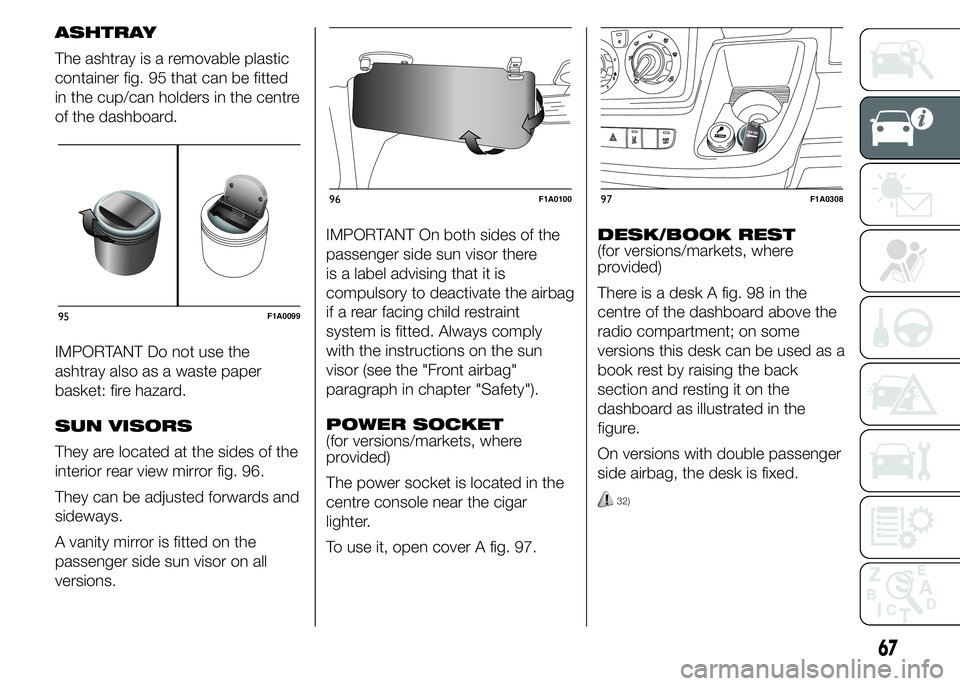
ASHTRAY
The ashtray is a removable plastic
container fig. 95 that can be fitted
in the cup/can holders in the centre
of the dashboard.
IMPORTANT Do not use the
ashtray also as a waste paper
basket: fire hazard.
SUN VISORS
They are located at the sides of the
interior rear view mirror fig. 96.
They can be adjusted forwards and
sideways.
A vanity mirror is fitted on the
passenger side sun visor on all
versions.IMPORTANT On both sides of the
passenger side sun visor there
is a label advising that it is
compulsory to deactivate the airbag
if a rear facing child restraint
system is fitted. Always comply
with the instructions on the sun
visor (see the "Front airbag"
paragraph in chapter "Safety").
POWER SOCKET
(for versions/markets, where
provided)
The power socket is located in the
centre console near the cigar
lighter.
To use it, open cover A fig. 97.DESK/BOOK REST
(for versions/markets, where
provided)
There is a desk A fig. 98 in the
centre of the dashboard above the
radio compartment; on some
versions this desk can be used as a
book rest by raising the back
section and resting it on the
dashboard as illustrated in the
figure.
On versions with double passenger
side airbag, the desk is fixed.
32)
95F1A0099
96F1A010097F1A0308
67
Page 96 of 367
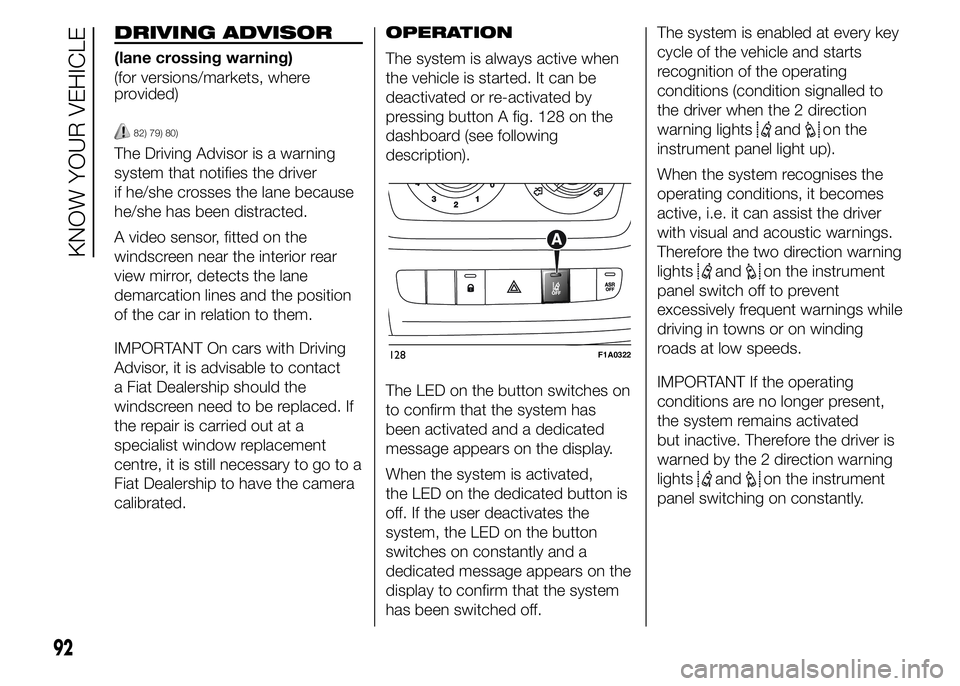
DRIVING ADVISOR
(lane crossing warning)
(for versions/markets, where
provided)
82) 79) 80)
The Driving Advisor is a warning
system that notifies the driver
if he/she crosses the lane because
he/she has been distracted.
A video sensor, fitted on the
windscreen near the interior rear
view mirror, detects the lane
demarcation lines and the position
of the car in relation to them.
IMPORTANT On cars with Driving
Advisor, it is advisable to contact
a Fiat Dealership should the
windscreen need to be replaced. If
the repair is carried out at a
specialist window replacement
centre, it is still necessary to go to a
Fiat Dealership to have the camera
calibrated.OPERATION
The system is always active when
the vehicle is started. It can be
deactivated or re-activated by
pressing button A fig. 128 on the
dashboard (see following
description).
The LED on the button switches on
to confirm that the system has
been activated and a dedicated
message appears on the display.
When the system is activated,
the LED on the dedicated button is
off. If the user deactivates the
system, the LED on the button
switches on constantly and a
dedicated message appears on the
display to confirm that the system
has been switched off.The system is enabled at every key
cycle of the vehicle and starts
recognition of the operating
conditions (condition signalled to
the driver when the 2 direction
warning lights
andon the
instrument panel light up).
When the system recognises the
operating conditions, it becomes
active, i.e. it can assist the driver
with visual and acoustic warnings.
Therefore the two direction warning
lights
andon the instrument
panel switch off to prevent
excessively frequent warnings while
driving in towns or on winding
roads at low speeds.
IMPORTANT If the operating
conditions are no longer present,
the system remains activated
but inactive. Therefore the driver is
warned by the 2 direction warning
lights
andon the instrument
panel switching on constantly.
128F1A0322
92
KNOW YOUR VEHICLE
Page 103 of 367
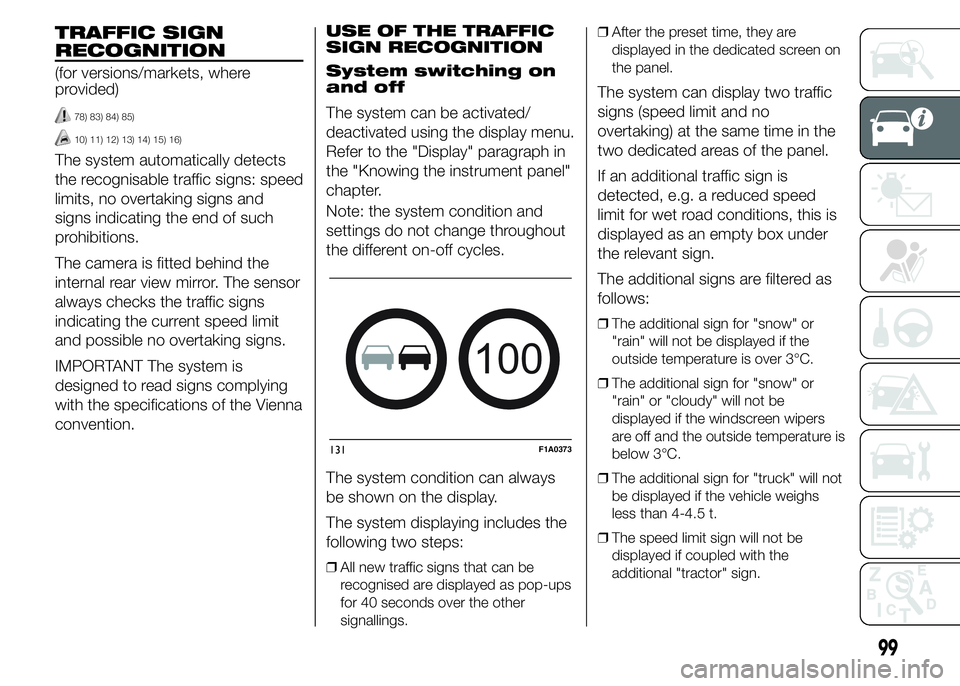
TRAFFIC SIGN
RECOGNITION
(for versions/markets, where
provided)
78) 83) 84) 85)
10) 11) 12) 13) 14) 15) 16)
The system automatically detects
the recognisable traffic signs: speed
limits, no overtaking signs and
signs indicating the end of such
prohibitions.
The camera is fitted behind the
internal rear view mirror. The sensor
always checks the traffic signs
indicating the current speed limit
and possible no overtaking signs.
IMPORTANT The system is
designed to read signs complying
with the specifications of the Vienna
convention.USE OF THE TRAFFIC
SIGN RECOGNITION
System switching on
and off
The system can be activated/
deactivated using the display menu.
Refer to the "Display" paragraph in
the "Knowing the instrument panel"
chapter.
Note: the system condition and
settings do not change throughout
the different on-off cycles.
The system condition can always
be shown on the display.
The system displaying includes the
following two steps:
❒All new traffic signs that can be
recognised are displayed as pop-ups
for 40 seconds over the other
signallings.❒After the preset time, they are
displayed in the dedicated screen on
the panel.
The system can display two traffic
signs (speed limit and no
overtaking) at the same time in the
two dedicated areas of the panel.
If an additional traffic sign is
detected, e.g. a reduced speed
limit for wet road conditions, this is
displayed as an empty box under
the relevant sign.
The additional signs are filtered as
follows:
❒The additional sign for "snow" or
"rain" will not be displayed if the
outside temperature is over 3°C.
❒The additional sign for "snow" or
"rain" or "cloudy" will not be
displayed if the windscreen wipers
are off and the outside temperature is
below 3°C.
❒The additional sign for "truck" will not
be displayed if the vehicle weighs
less than 4-4.5 t.
❒The speed limit sign will not be
displayed if coupled with the
additional "tractor" sign.
100
131F1A0373
99
Page 364 of 367
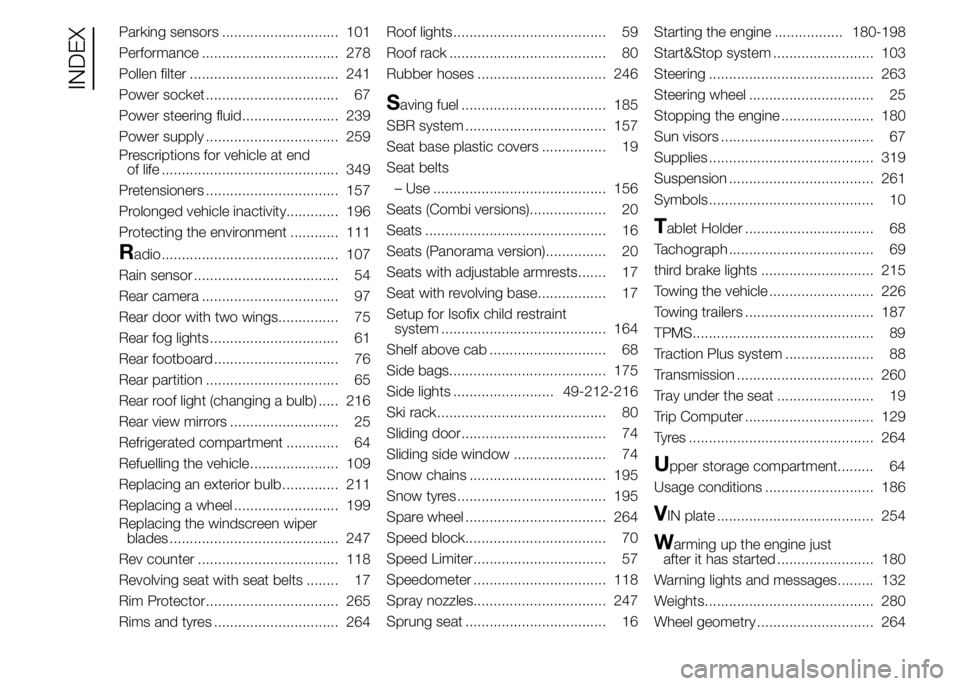
Parking sensors ............................. 101
Performance .................................. 278
Pollen filter ..................................... 241
Power socket ................................. 67
Power steering fluid........................ 239
Power supply ................................. 259
Prescriptions for vehicle at end
of life ............................................ 349
Pretensioners ................................. 157
Prolonged vehicle inactivity............. 196
Protecting the environment ............ 111
Radio ............................................ 107
Rain sensor .................................... 54
Rear camera .................................. 97
Rear door with two wings............... 75
Rear fog lights ................................ 61
Rear footboard ............................... 76
Rear partition ................................. 65
Rear roof light (changing a bulb) ..... 216
Rear view mirrors ........................... 25
Refrigerated compartment ............. 64
Refuelling the vehicle ...................... 109
Replacing an exterior bulb .............. 211
Replacing a wheel .......................... 199
Replacing the windscreen wiper
blades .......................................... 247
Rev counter ................................... 118
Revolving seat with seat belts ........ 17
Rim Protector................................. 265
Rims and tyres ............................... 264Roof lights...................................... 59
Roof rack ....................................... 80
Rubber hoses ................................ 246
Saving fuel .................................... 185
SBR system ................................... 157
Seat base plastic covers ................ 19
Seat belts
– Use ........................................... 156
Seats (Combi versions)................... 20
Seats ............................................. 16
Seats (Panorama version)............... 20
Seats with adjustable armrests....... 17
Seat with revolving base................. 17
Setup for Isofix child restraint
system ......................................... 164
Shelf above cab ............................. 68
Side bags....................................... 175
Side lights ......................... 49-212-216
Ski rack.......................................... 80
Sliding door.................................... 74
Sliding side window ....................... 74
Snow chains .................................. 195
Snow tyres ..................................... 195
Spare wheel ................................... 264
Speed block................................... 70
Speed Limiter................................. 57
Speedometer ................................. 118
Spray nozzles................................. 247
Sprung seat ................................... 16Starting the engine ................. 180-198
Start&Stop system ......................... 103
Steering ......................................... 263
Steering wheel ............................... 25
Stopping the engine ....................... 180
Sun visors ...................................... 67
Supplies ......................................... 319
Suspension .................................... 261
Symbols......................................... 10
Tablet Holder ................................ 68
Tachograph .................................... 69
third brake lights ............................ 215
Towing the vehicle .......................... 226
Towing trailers ................................ 187
TPMS............................................. 89
Traction Plus system ...................... 88
Transmission .................................. 260
Tray under the seat ........................ 19
Trip Computer ................................ 129
Tyres .............................................. 264
Upper storage compartment......... 64
Usage conditions ........................... 186
VIN plate ....................................... 254
Warming up the engine just
after it has started ........................ 180
Warning lights and messages......... 132
Weights.......................................... 280
Wheel geometry ............................. 264
INDEX